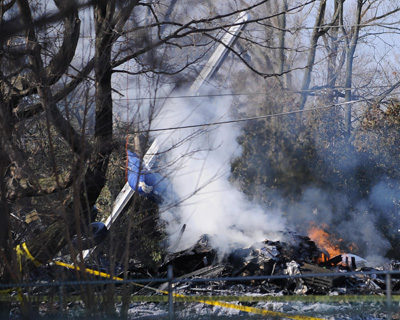
There are a few similarities between the crash of a regional jet near Buffalo last week and the 1993 crash of a regional flight on approach to the airport in Hibbing, but ice isn’t one of them. The Star Tribune noted this week — incorrectly, by the way — that icing contributed to the Northwest Airlink crash. It didn’t. The plane crashed because a poorly trained pilot executed a banned procedure to avoid suspected icing, and lost track of the altitude of his plane. An additional cause was that the younger co-pilots in the airline were too intimidated to call the pilot on his actions.
“It was a textbook flight right up until the moment it crashed,” Mike Brady, the head of the airline that operated the flight told me and reporter Elizabeth Stawicki. We conducted an investigation of the crash which revealed poor FAA oversight of the airline, poor training in the airline, lax monitoring of the actions of pilots, and a system of “branding” among airlines that masked the fact — at the time — that when passengers transferred from a Northwest Airlines flight to a plane dressed up to look like a Northwest Airlines plane (except for the logo), they stepped into a substantially different world of airline safety — a substantially less safe world.
Northwest Airlink wasn’t Northwest Airlines. It was actually Express II Airlines, with which Northwest contracted to run the flights to some outstate Minnesota destinations.
Express II is gone now. The federal rules under which the “hidden” airlines operated have been tightened. The requirements for safety equipment on the regional planes are much tighter now than in 1993. Training has been standardized.
Since 9/11, airlines have increasingly turned to their hidden airlines. And they are still doing their best to make sure you think it’s all one big airline. It’s not. Passengers quite often aren’t on the big airline they think they’re on.
Just this morning, for example, I heard one network reporter refer to the jet that crashed in Buffalo as Continental Flight 3407. It was painted in the colors of Continental Airlines (See image here). But it wasn’t a flight operated by Continental Airlines, and the pilots weren’t employed by Continental Airlines.
It was a flight operated by Colgan Air. Colgan, in turn, is a wholly-owned subsidiary of Pinnacle Airlines. Pinnacle specializes in providing the regional jet flights under contract to big airlines, but the airline is not managed by the larger airline. It operates several “Northwest” flights.
“We leave safety monitoring to the FAA,” said a Continental spokeswoman about their pact with Pinnacle and Colgan.
Regional jets are not, by definition, dangerous airplanes. But there is an undeniable fact in the aviation industry: The more experienced a pilot and first officer, the better aviators they are, and the better able they generally would be at handling quickly developing emergencies. Flight crews at these “hidden airlines” are in the comparatively early stage of becoming the next Chesley Sullenberger. Generally, the “hidden airlines” are the entry-level steps to becoming an airline pilot at a major carrier.
Of the five employees on the Colgan Air flight to Buffalo, none had more than four years of experience. The co-pilot on the ill-fated airplane, Rebecca Shaw, joined the airline only last year. She had not yet acquired an Air Transport Pilot rating, which — among other things — requires a minimum of 1,500 flight hours of experience. Shaw had over 2,000 hours with the airline, however.
The pilot, Marvin Renslow, who joined the airline in 2005, was 48. He had over 3,000 hours with Colgan, but no other airline experience.
Pilots for regional carriers are not incompetent pilots. Far from it. But they are not the industry’s most experienced pilots. Of course, we don’t know why the Colgan plane crashed. The weather certainly seems to have been a challenge. Based on NTSB investigations of previous disasters, however, how pilots respond to those challenges is what separates a happy landing from a tragic accident.
Since 2000, there have been eight crashes of regional aircraft. Only one did not involve fatalities. Three of the incidents involved Pinnacle Airlines, Colgan Air’s parent company. In one 2004 crash, two pilots of an empty airplane (on its way to Minneapolis St. Paul) died in a crash after they tried to see how high the airplane could go.
Speaking to the Regional Airline Association just four months ago, Robert Sumwalt, the vice chair of the National Transportation Safety Board indicated he has concerns about the safety level of regional carriers:
When a passenger buys a ticket on an airline to go from say, Columbia, SC to San Francisco, he or she may find that the flight from Columbia to a hub city is being operated by a regional airline that is partnering with a major airline, while the next leg will be on a major airline.
The tickets would be issued on the major airline’s ticket stock, the passenger would check in through the major airline’s ticket counter and they would board planes that are painted in that major airline’s livery.
Doesn’t that passenger deserves the same level of safety while traveling on the regional airline portion of that flight as they receive on the portion flown by the major airline?
Sumwalt said he sees some evidence they’re not.
(Photo: Stan Honda/Getty Images)
